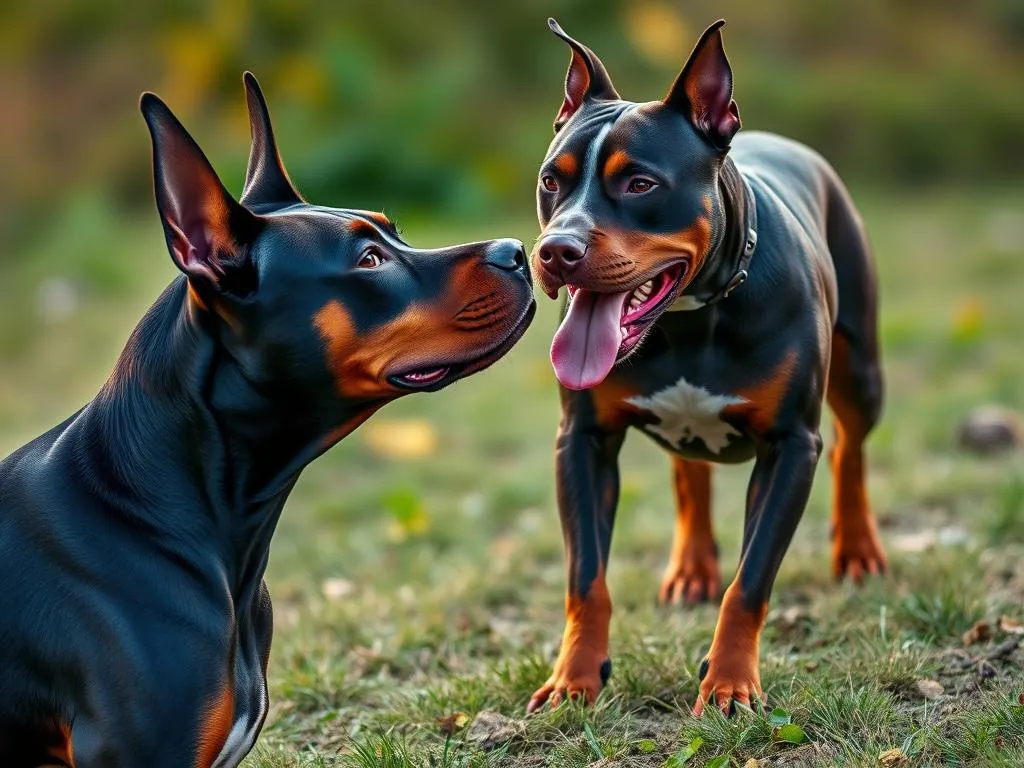
When considering a new canine companion, potential dog owners often find themselves weighing the pros and cons of various breeds. Among the most discussed are the Doberman Pinscher and the American Pitbull Terrier. Both breeds have distinct characteristics, temperaments, and needs that can significantly impact their suitability as family pets. Understanding these factors is essential for making an informed decision about which breed aligns best with your lifestyle.
General Overview of Dog Breeds
Definition of Dog Breeds
A dog breed is defined as a specific group of domesticated dogs with particular characteristics that distinguish them from others. These traits can include size, coat type, temperament, and behavior. Understanding breed characteristics is crucial when selecting a dog, as they can significantly influence the pet’s compatibility with your household.
Role of Breeds in Canine Behavior
The influence of breed on a dog’s behavior cannot be understated. Different breeds have been developed for various purposes, such as herding, guarding, or companionship, which shapes their instincts and behavior. For instance, breeds like Dobermans were originally bred for protection, while Pitbulls were cultivated for their strength and agility. Understanding these historical contexts can help potential dog owners anticipate their future pet’s behavior and training needs.
Introduction to Doberman Pinschers
History and Origin
The Doberman Pinscher was developed in the late 19th century by a tax collector named Karl Friedrich Louis Dobermann in Germany. He sought a loyal and protective dog to accompany him on his rounds, leading to the breeding of a versatile companion known for its intelligence, loyalty, and guarding instincts. Over the years, Dobermans have been utilized in various roles, including police and military work, search and rescue, and as family pets.
Physical Characteristics
Dobermans are medium to large-sized dogs, typically weighing between 60 to 100 pounds and standing about 24 to 28 inches tall at the shoulder. They possess a sleek, muscular build, and their coat is short and smooth, usually found in black, blue, red, or fawn. Many Dobermans undergo ear cropping and tail docking, which are practices aimed at enhancing their appearance and perceived functionality.
Temperament and Behavior
Known for their loyalty and intelligence, Dobermans make excellent companions when trained and socialized properly. They are protective of their families and can be wary of strangers, making them effective guard dogs. However, their temperament can vary based on individual upbringing, training, and socialization experiences. Early socialization is crucial to ensure they grow into well-mannered adults.
Health Considerations
Dobermans are generally healthy dogs, but they are prone to specific health issues, including hip dysplasia, dilated cardiomyopathy, and von Willebrand disease. Their average lifespan ranges from 10 to 12 years. Regular veterinary check-ups, a balanced diet, and proper exercise can help mitigate some health risks.
Introduction to American Pitbull Terriers
History and Origin
The American Pitbull Terrier originated in the United States during the 19th century, derived from bulldog and terrier breeds. Initially bred for bull-baiting and later as farm dogs, they were known for their strength and tenacity. Despite their tumultuous history, modern Pitbulls are often bred for companionship and are recognized for their affectionate nature.
Physical Characteristics
Pitbulls are muscular and stocky, weighing between 30 to 85 pounds and standing around 17 to 21 inches tall. Their coat is short and smooth, typically found in various colors and patterns. Unlike Dobermans, Pitbulls do not commonly undergo ear cropping or tail docking, leading to a more natural appearance.
Temperament and Behavior
Pitbulls are renowned for their affectionate and loyal nature. They are often described as “people-oriented” and thrive on human interaction. With proper training and socialization, they can be playful, energetic, and well-mannered companions. However, like any breed, their behavior can be influenced by individual upbringing and environmental factors.
Health Considerations
Pitbulls are generally robust dogs, but they can be prone to certain health issues such as hip dysplasia, skin allergies, and heart disease. Their lifespan averages between 12 to 16 years. Regular exercise, a healthy diet, and routine vet visits are essential for maintaining their health and well-being.
Doberman vs. Pitbull: Key Comparisons
Size and Physical Attributes
When comparing Doberman vs Pitbull, size and appearance are significant factors. Dobermans tend to be larger and more muscular, with a more refined build compared to the stockier, robust form of Pitbulls. This difference in size can influence their suitability for various living situations, such as apartments versus houses with yards.
Temperament and Personality Comparison
In terms of temperament, both breeds exhibit loyalty and affection towards their families. Dobermans are often more reserved with strangers, while Pitbulls typically display a friendly demeanor. When considering family dynamics, Dobermans may be better suited for families seeking a protective companion, while Pitbulls can be ideal for active households looking for a playful, affectionate pet.
Trainability and Intelligence
Both breeds are intelligent and eager to please, making them relatively easy to train. However, Dobermans often excel in obedience and can be trained for specific tasks, given their history in guard and service roles. Pitbulls, while intelligent, may require more patience and consistency during training due to their spirited nature. Employing positive reinforcement techniques works well for both breeds, promoting a happy and productive training environment.
Exercise and Activity Requirements
Both Doberman and Pitbull breeds are energetic and require regular exercise to maintain their physical and mental well-being. Dobermans may need more vigorous activities, such as running or agility training, while Pitbulls enjoy interactive play and can adapt to various exercise routines. Daily walks, playtime, and mental stimulation are vital to prevent behavioral issues stemming from boredom.
Grooming and Maintenance
In terms of grooming, both breeds have relatively low maintenance needs due to their short coats. Regular brushing helps reduce shedding and keeps their coats healthy. However, Dobermans may require additional care for their cropped ears and docked tails to avoid infections. Bathing should be done as needed for both breeds, taking care to use appropriate dog shampoos.
Suitability as Family Pets
Family Dynamics
When considering family dynamics, both breeds can adapt well, but their interactions with children and other pets are essential to assess. Dobermans may be more protective and cautious, especially around unfamiliar faces. In contrast, Pitbulls are often affectionate and playful, making them great companions for families with children. Early socialization is critical for both breeds to ensure they develop into well-rounded pets.
Protective Instincts
Both Dobermans and Pitbulls possess protective instincts; however, they manifest differently. Dobermans are known for their guarding abilities and may take on protective roles with their families. Pitbulls can also display protective behavior but are generally more inclined to socialize and play. Understanding these traits can help potential owners choose a breed that aligns with their personal preferences and security needs.
Pros and Cons of Each Breed
Doberman Pros and Cons
Pros:
– Intelligent and trainable
– Protective and loyal
– Good watchdogs
Cons:
– Requires consistent socialization
– Can be wary of strangers
– Prone to specific health issues
Pitbull Pros and Cons
Pros:
– Affectionate and loyal
– Good with children when socialized
– Energetic and playful
Cons:
– Can be stubborn during training
– Requires strong leadership
– Misunderstood due to breed stigma
Conclusion
In comparing Doberman vs Pitbull, it becomes clear that both breeds offer unique characteristics that cater to different lifestyles and family needs. Dobermans are often seen as loyal protectors, while Pitbulls are known for their affectionate nature. When choosing between these two breeds, consider factors such as family dynamics, activity levels, and training capabilities. Ultimately, understanding these nuances will help you select the right breed to call your own. Whether you opt for a Doberman or a Pitbull, both can provide love, companionship, and joy to your home.









